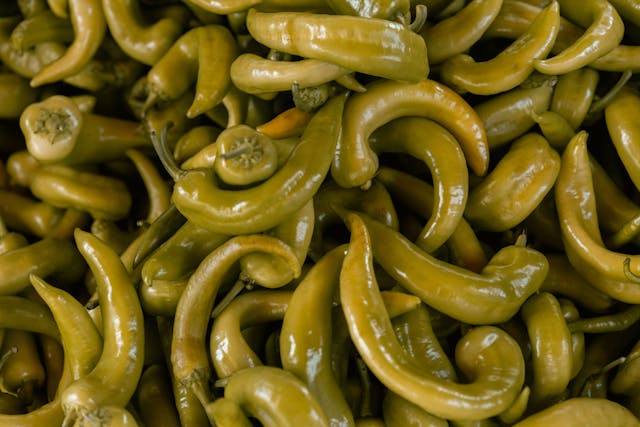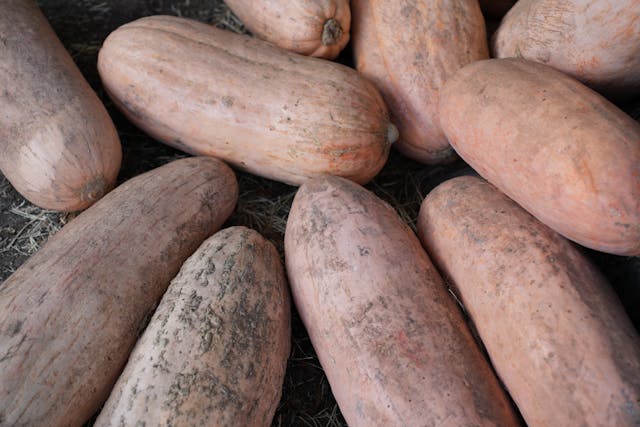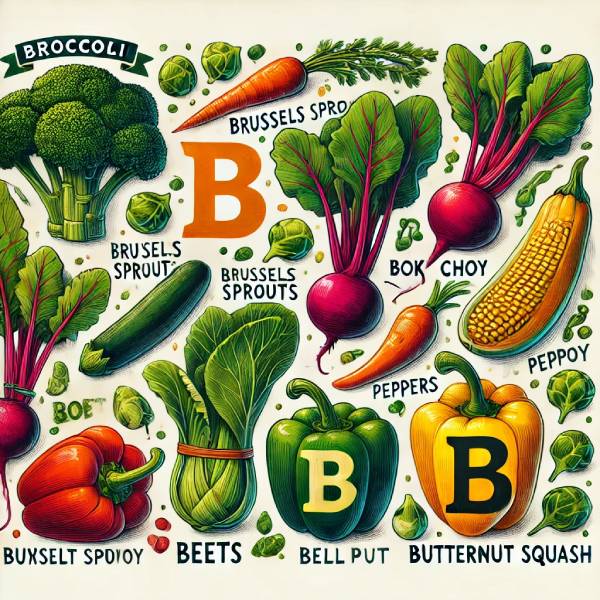Vegetables play a vital role in cuisines worldwide, offering an array of flavors, textures, and nutritional benefits. Among these, vegetables that start with the letter “B” stand out for their diversity and significance in both Indian and American diets. This comprehensive guide explores the unique qualities, culinary uses, and health benefits of these “B” vegetables, ensuring a fresh perspective on incorporating them into daily meals.
1. Bamboo Shoots
Bamboo shoots are the tender, young sprouts of the bamboo plant. Popular in Asian cuisines, they add a crisp texture and a mild flavor to dishes. In India, particularly in the northeastern states, bamboo shoots are fermented and incorporated into traditional recipes. They are often used in stir-fries, soups, and salads in the USA. Bamboo shoots are low in calories and a rich source of fiber and potassium, making them a healthy addition to any meal.

Culinary Uses:
- Stir-fries with soy sauce and garlic.
- Soups like hot and sour or miso.
- Salads with sesame oil dressing.
Nutritional Highlights:
- Low calorie: Ideal for weight management.
- Rich in potassium: Supports heart health.
- High in dietary fiber: Promotes digestive health.
2. Banana Pepper
Banana peppers are medium-sized chilli peppers known for their tangy taste and mild heat. They are widely used in American cuisine in sandwiches, salads, and pickled forms. In India, similar peppers are used in pickles and as stuffing for fried snacks. Their vibrant flavour and crunch make them a favourite.

Culinary Uses:
- Pickled and added to burgers or subs.
- Stuffed with cheese and baked.
- Sliced into salads for a zesty kick.
Nutritional Highlights:
- Vitamin A: Supports vision and immunity.
- Vitamin C: Enhances skin health and immune function.
- Low in calories: Perfect for light snacks.
3. Banana Squash
Banana squash, a winter squash variety, is characterized by its elongated shape and sweet, nutty flavor. While it’s more commonly used in the USA for baking, roasting, and soups, similar squashes are integral to Indian curries and desserts. Its versatility and nutritional benefits make it a valuable vegetable.

Culinary Uses:
- Roasted with herbs and olive oil.
- Mashed as a side dish.
- Added to soups and stews for a creamy texture.
Nutritional Highlights:
- High in vitamins A and C: Supports skin health and immunity.
- Good source of fiber: Aids in digestion.
- Low in fat: Suitable for heart-healthy diets.
4. Baobab Leaves
Baobab leaves are a lesser-known vegetable consumed in parts of Africa and regions influenced by African cuisine. In India, they are used in soups and sauces and are appreciated for their high calcium and iron content.

Culinary Uses:
- Cooked into stews and soups.
- Used as a garnish in curries.
- Dried and ground into a powder for teas.
Nutritional Highlights:
- High in calcium: Strengthens bones and teeth.
- Rich in iron: Helps combat anemia.
- Antioxidants: Supports overall health.
5. Basil
Basil, known for its aromatic fragrance, is a globally popular herb. In India, holy basil (tulsi) has cultural and medicinal importance, while sweet basil is used in a variety of dishes. In the USA, it’s a staple in Italian cuisine, particularly in pesto and pasta recipes.

Culinary Uses:
- Pesto sauce for pasta.
- Fresh leaves in salads or sandwiches.
- Infused in herbal teas or drinks.
Nutritional Highlights:
- Antioxidants: Protect against free radical damage.
- Anti-inflammatory properties: Reduce inflammation.
- Vitamin K: Promotes bone health.
6. Batata (Sweet Potato)
Sweet potato, also known as batata in India, is a starchy root vegetable cherished for its natural sweetness. In India, it’s a popular ingredient in curries, snacks, and desserts, particularly during fasting periods. In the USA, sweet potatoes are common in casseroles, fries, and pies.
Culinary Uses:
- Baked and topped with cinnamon.
- Mashed for pies and desserts.
- Added to curries for a sweet flavor.
Nutritional Highlights:
- High in beta-carotene: Supports vision.
- Rich in fiber: Aids digestion.
- Contains antioxidants: Promotes overall health.
7. Bean Sprouts
Bean sprouts, especially mung bean sprouts, are a popular addition to healthy diets. In India, they are used in salads, stir-fries, and chaats. In the USA, they are a staple in Asian-inspired dishes like Pad Thai.
Culinary Uses:
- Tossed in salads with a lemon dressing.
- Stir-fried with soy sauce and sesame oil.
- Added to soups for a crunchy texture.
Nutritional Highlights:
- Low in calories: Ideal for weight loss.
- High in vitamin C: Boosts immunity.
- Good source of protein: Supports muscle health.
8. Beetroot
Beetroot’s vibrant color and earthy flavor make it a versatile root vegetable. In India, it’s used in pickles, salads, and juices, while in the USA, it’s a key ingredient in roasted vegetable dishes and smoothies.
Culinary Uses:
- Grated into salads.
- Blended into smoothies or juices.
- Roasted with olive oil and herbs.
Nutritional Highlights:
- Rich in folate: Supports cell growth.
- Contains dietary nitrates: Helps lower blood pressure.
- High in manganese: Promotes bone health.
9. Belgian Endive
Belgian endive is a slightly bitter leafy vegetable. It’s commonly used in American salads and appetizers. While not widely used in India, similar bitter greens are part of traditional diets.
Culinary Uses:
- Used in salads with vinaigrette.
- Stuffed with cheese and baked.
- Grilled as a side dish.
Nutritional Highlights:
- Low in calories: Suitable for weight management.
- Good source of fiber: Supports digestion.
- Contains vitamins A and K: Promotes healthy vision and blood clotting.
10. Bell Pepper (Capsicum)
Bell peppers, also called capsicum in India, are widely used in various dishes. Their mild sweetness and crunchy texture make them a versatile ingredient in global cuisines.
Culinary Uses:
- Added to stir-fries and curries.
- Stuffed with rice or cheese and baked.
- Sliced raw into salads.
Nutritional Highlights:
- High in vitamin C: Strengthens the immune system.
- Contains antioxidants: Supports overall health.
- Low in calories: Ideal for light meals.
11. Bintje Potato
Bintje is a creamy-textured potato variety popular in Europe and the USA. Although uncommon in India, potatoes are a staple ingredient in Indian cuisine, used in curries, snacks, and parathas.
Culinary Uses:
- Mashed for creamy side dishes.
- Fried into crispy chips or wedges.
- Boiled and added to salads.
Nutritional Highlights:
- High in potassium: Helps regulate blood pressure.
- Good source of vitamin C: Boosts immunity.
- Contains complex carbohydrates: Provides sustained energy.
12. Bitter Melon (Karela)
Bitter melon, or karela in India, is known for its distinct bitterness and health benefits. It is a common ingredient in Indian stir-fries and stuffed dishes, and its medicinal properties are celebrated globally.
Culinary Uses:
- Sliced and stir-fried with spices.
- Stuffed with a mixture of spices and cooked.
- Juiced for its health benefits.
Nutritional Highlights:
- High in antioxidants: Reduces oxidative stress.
- Supports blood sugar regulation.
- Rich in vitamin C: Enhances immunity.
13. Black Bean
Black beans are a staple in American cuisine, particularly in Latin-inspired dishes like burritos and soups. In India, similar legumes are used in curries and stews.
Culinary Uses:
- Cooked into a hearty soup.
- Added to salads and grain bowls.
- Used in vegetarian tacos or burritos.
Nutritional Highlights:
- High in protein: Supports muscle repair.
- Rich in fiber: Promotes digestive health.
- Good source of folate: Supports cell growth.
14. Black Radish
Black radish has a strong, peppery flavor and is often used in salads or as a natural remedy for digestive issues. In India, radishes are incorporated into parathas and pickles.
Culinary Uses:
- Sliced thinly into salads.
- Grated into slaws.
- Roasted for a caramelized flavor.
Nutritional Highlights:
- High in vitamin C: Supports skin and immune health.
- Contains detoxifying properties.
- Rich in fiber: Aids digestion.
15. Black Salsify
Black salsify, also called scorzonera, is a root vegetable with a flavor resembling oysters. Though less common in India, similar roots are used in traditional recipes.
Culinary Uses:
- Boiled and mashed as a side dish.
- Roasted with olive oil.
- Added to soups for depth of flavor.
Nutritional Highlights:
- High in iron: Helps prevent anemia.
- Good source of dietary fiber.
- Contains antioxidants: Supports overall health.
16. Black-Eyed Pea (Lobia)
Black-eyed peas are versatile legumes popular in Indian and American cuisines. In India, they are cooked in curries, while in the USA, they are a key ingredient in Southern dishes like Hoppin’ John.
Culinary Uses:
- Stewed with spices and tomatoes.
- Added to salads or grain bowls.
- Mashed and formed into patties.
Nutritional Highlights:
- High in protein: Supports muscle development.
- Rich in folate: Aids in cell repair.
- Good source of fiber: Promotes gut health.
By exploring these vegetables, starting with “B,” one can embrace various culinary traditions and nutritional benefits. Incorporating these versatile and healthy options into daily meals can elevate flavor and wellness.
Also, check out: 13+ Vegetables Name Start With A Letter



